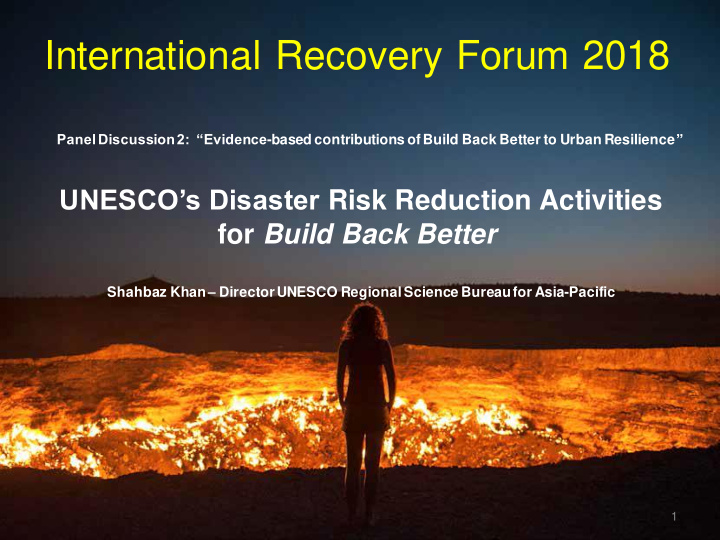



International Recovery Forum 2018 Panel Discussion 2: “Evidence -based contributions of Build Back Better to Urban Resilience ” UNESCO’s Disaster Risk Reduction Activities for Build Back Better Shahbaz Khan – Director UNESCO Regional Science Bureau for Asia-Pacific 1
Disaster Risk Reduction: UNESCO’s role UNESCO’s Crisis Preparedness and Response follows its mandate for humanity : it aims to foster social cohesion and resilience and to enable dialogue. “traditional” While actions during an emergency are concerned with basic physical needs (e.g. water, food, shelter), UNESCO’s crisis response within the broader humanitarian or recovery effort replies to social needs for education, human rights, freedom of expression, creativity, expression of identities, etc . 2
Disaster Risk Reduction: UNESCO’s activities (Response phase) (Recovery phase) Build Disaster Back occurs Better VISUS-PDNA Field Investigation Guidelines (for educational facilities) (to draw lessons) (for non engineered building) (Current activities) VISUS <Collaboration POST-DISASTER with IPRED> INDRA (learning from vernacular construction) Developing comprehensive guideline (for post-disaster evaluations) (Future activities) Strengthening Capacity for Assessing School (through the implementation of the VISUS methodology) In collaboration with UNESCO’s specialist Networks 3
Current activity: Collaboration with IPRED - Together with the members of IPRED*, UNESCO published technical and policy guidelines to help member states to secure the safety of non-engineered construction and to support science-based policy making . - Additionally, a system was established to dispatch experts to earthquake stricken countries in order to carry out post-earthquake field investigations and draw lessons for future risk reduction. Policy/technical Guidelines Post-earthquake on non-engineered buildings field investigations T o date, two IPRED missions have been carried out: Van, Turkey in 2012 Bohol, Philippines in 2014. T echnical approaches for Structural Improvement of UNESCO publications Non-Engineered Construction Bohol, Philippines Mission report * IPRED (International Platform for Reducing Earthquake Disaster) - A platform for collaborative research, training and education in the field of seismology - Aims to reduce disasters due to earthquakes with a focus on earthquake-resistant buildings and housings. - Supported by the Ministry of Land, Infrastructure, Transport and T ourism (MLIT) of Japan. - Center of the Excellence: UNESCO / IISEE of Japan 4 - Member: Chile, Egypt, El Salvador, Indonesia, Kazakhstan, Mexico, Peru, Romania, Turkey
Future activity: INDRA - UNESCO promotes a holistic approach towards international disaster resilient architecture by learning from vernacular construction . - Contemporary construction and vernacular construction techniques can be brought together to create buildings that are resilient, sustainable and adapted to the local environment . - UNESCO supports Member States in capacity building of the local construction sector through workshops, trainings and publication of guidelines about the important role of construction to create a disaster resilient environment. Impact: - Climate change mitigation and adaptation - Consideration of local culture and environment - Business continuity - Improve overall economy - Reduce greenhouse gas emissions 5 - Build back better Flood and earthquake proof buildings in Nias, Indonesia
UNESCO’s DRR Activities Culture Strategy for Reducing Risks from Disasters at World Heritage Properties • Training Workshops • International T echnical Assistance • Emergency Response • Awareness-raising and Education
UNESCO’s DRR and Education for Sustainable Development A Comprehensive Framework for School Safety Education sector Identifies three overlapping pillars: 1. Safe Learning Facilities, 2. School Disaster Management, and 3. Risk Reduction and Comprehensive School Resilience Education Safety Framework with the following goals: • To protect learners and education workers from physical harm in schools; • To prevent interruption of the provision of education when faced with hazards; • To safeguard education sector investments; • To strengthen climate change adaptation and mitigation competencies and disaster resilience through education The Global Action Programmefor Education on Sustainable Development (GAP)
Disaster Risk Reduction: Science Bureau For ASPAC REGIONAL SCIENCE BUREAU FOR ASIA AND THE PACIFIC UNESCO Office Jakarta Science, Engineering, Technology, and Innovation for Disaster Risk Reduction 2017 - 2021 8
EXAMPLE FROM THE REGION Protecting People from Marine Hazards: Tsunami UNESCO, through the Intergovernmental Oceanographic Commission (IOC/UNESCO), works with the Member States to build sustainable tsunami early warning and mitigation systems. • Tsunami risk assessment includes the evaluation of the hazard and the levels of vulnerability of coastal communities. • Development and coordination of tsunami early warning and mitigation systems based in the Indian Ocean • Tsunami Evacuation Maps, Plans and Procedures based on Tsunami Modeling and Inundation Modeling
EXAMPLE FROM THE REGION Mobile Application for Recovery TANAH and SAI FAH are prime examples of educational gamification for disaster risk reduction. The mobile apps provide integral lessons on, and reinforces the importance of, disaster preparedness, through exploring potential situations that may occur. Offered as platform-based games with various levels, users are provided with key survival lessons for all phases of disaster in an interactive manner. While SAI FAH disseminates information on flood preparedness and survival, TANAH teaches users how to prepare, respond to and recover from tsunamis and earthquakes. Both succeed in their underlying objectives of delivering quality, interactive, and accurate material in an organic way to a wide audience.
EXAMPLE FROM THE REGION FLOOD TECHNOLOGY & DISASTER RISK REDUCTION Strategic Strengthening of Flood Warning and Management Capacity in Pakistan Following the 2010 Pakistan floods, UNESCO with the aid of the Government of Japan supported the Flood Warning and Management Capacity of Pakistan' project. The project focused on strengthening the country's capacity to deal with floods and watershed management in a holistic manner by developing 3 inter-related pillars; strategic augmenting of flood forecasting and hazard maps; data sharing platforms; and capacity development. • Establishment of the technical foundation for sustainable capacity development on the flood management, forecasting, early warning and flood hazard analysis in Pakistan agencies. • Technical studies to promote strengthening of cooperation with Indus river basin countries for transboundary flood management and transboundary data sharing. • Capacity building and education to community on flood management for proper utilization of flood hazard information and tools
Recommend
More recommend